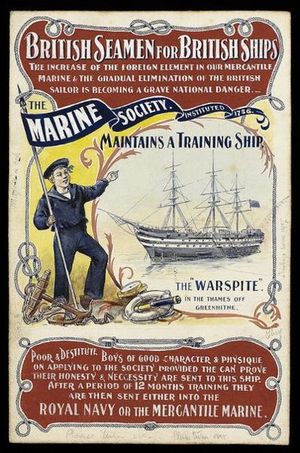Training ship

A training ship, also known as a school ship, is a ship used for the training of boys as sailors, example for later use in the British Royal Navy. Such training ships have existed e.g. on the River Thames since 1786, and became very popular in the 19th century. The first training ships were set up to help the poor, and many of their recruits were orphans.
Life onboard a training ship was hard, with very little time off. The boys were educated while living on board. The new recruits were supervized by a superintendent, mate, schoolmaster, boatswain and cook.
Punishment on training ships
Discipline was always very strict on such ships and there was a lot of corporal punishment for the boys, given e.g. with a rope's end, tawse, birch rod or cane on their bottoms. Corporal punishment on training ships continued well into the 20th century. Up until the 1930s, the Captain of the Arethusa, for example, could administer:
- 6 strokes with a birch for being in an improper place
- 12 strokes with a birch for stealing
- 24 strokes with a birch for an act of gross indecency or immoral behavior
The only changes made to this were in 1937: no boy under the age of 12 could have more than six strokes and the punishment had to be witnessed by several other officers.
Ships such as the Warspite could accommodate up to 200 boys each year by the 1940s.
The Captain, awarding me 15 strokes of the birch, told the man known as the Punishment Corporal: 'See that you give this rascal a sound flogging'. Having seen the ship's carpenter making the long whippy rods from supplies of fresh green well-budded birch switches brought aboard every so often, I quaked. All the boys paraded on the quarterdeck, where the flogging horse had been put out. I was stretched across it, with my legs and arms tied with canvas straps so that I couldn't move and my duck pants were pulled down. Then the Corporal, taking his time, birched me on my bare buttocks, swishing me with all the vigour he could muster.
I clenched my teeth and tried not to squeal, but at the third stroke I let out an ear-splitting yell. It was like nothing I had ever experienced - my weals burned and stung like fire and I howled unashamedly. When they released me from the horse, my bottom, cut and bleeding all over from the birch strokes, was like a white-hot ball of fire and I stood in front of the ship's company, weeping and squirming with the pain and humiliation. After a few weeks my scars disappeared and I was none the worse for being flogged. Indeed, the Akbar taught me self-respect and made a new boy of me. I have only praise for the officers, even the Corporal, who was a kindly man, but with a stern sense of duty. Training ships like this are what young hooligans need today.– An elderly man, who many years before had been consigned to the training ship 'Akbar' at the age of 15 for stealing, in a letter to his local newspaper to recommend the shipboard regime for today's 'young thugs.' source
Reformatory ships
There were also reformatory ships such as the Clarence or Akbar, which served the purpose of reformatories. Boys were sent to such ships for training after serving short prison sentences for committing crimes. It was hoped that the training they received on such ships would help to "reform their character".
See also
Links
- Training Ships with a good overview on the history
- Training ships on the River Thames
Chat rooms • What links here • Copyright info • Contact information • Category:Root